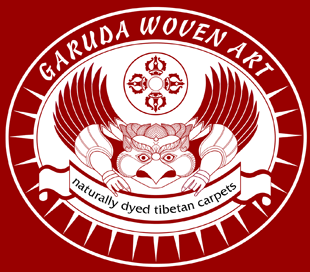Weaving Center
Garuda Woven Art rugs are made in Nepal at our own weaving center located in a small, agricultural village outside of Kathmandu.
The dyeing, weaving and washing are done on-site rather than being contracted out. This ensures control over the quality of the dyeing and weaving, and the assurance that no chemicals are used to wash or treat our rugs.
There is growing interest in the use of natural and sustainable products for home building and interior decorating. We are pleased to offer a product for those who desire a beautiful, yet less toxic home environment. We use no chemical dyes, washes, glues, mothproofing or stainproofing – all of which can off-gas.
Materials
The exceptional quality of our carpets is a result of returning to the basics and using the traditional materials and methods that give quality and integrity to antique oriental carpets. We begin with using the highest quality fibers available:
• handcarded, handspun pure Tibetan wool
• top grade Chinese silk
• unbleached cotton
Tibetan wool is known for its luster, strength and resiliency. Its high lanolin content makes it very soft and plush.
The hand-carding and hand-spinning process is more costly and labor intensive than the mechanical method. However, it is less abrasive to the wool; more of the natural oils (lanolin) are retained; and fewer fibers are broken. This results in wool with better texture and longevity. Rugs woven with Tibetan wool only become more beautiful with time. As the rugs are used and walked on, lanolin is released and a soft sheen naturally develops.

The Beauty of Natural Dyes
The rich, complex, lively qualities that result from using natural dyestuffs cannot be duplicated with synthetic dyes. As in antique rugs, the colors are harmonious and familiar. Hand-dyeing in small dyelots lends to gentle color variations (abrash) in the wool, making each rug unique.
Natural dyes are used exclusively. Our vegetal dye substances are wild-crafted in Nepal and India. They include: indigo, madder, cutch, lac, walnut and pomegranate. A mordant is necessary to bind the dye to the wool; we use alum, which is the safest mordant to use and dispose of. Our very involved and unique dye extraction process enables us to get impressive saturated colors.
We only use dyes that are light-fast and wash-fast.


